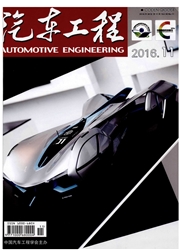

 中文摘要:
中文摘要:
为了建立选择性催化还原转化器(SCR)台架评价结果与欧洲稳态测试循环(ESC)工况条件下的减排效果之间的联系,进行了催化剂动态转化效率试验,绘制了基于反应平衡时间的SCR催化剂转化效率温度窗口,得到了不同反应温度下催化剂动态转化效率发展过程对反应平衡时间的依赖程度。基于ESC试验排放采样窗口期内发动机排气条件的特征分析,研究了ESC试验中催化剂动态转化效率发展特征,提出了基于该催化剂动态转化效率温度窗口表示方法,分析了温度窗口的试验评价条件和基于实际化学计量比(NSR)控制策略的窗口模拟计算调整方法。使用该温度窗口对ESC工况排放值进行预测,依据ESC名义转化效率温度窗口预测的ESC排放结果与实测值的偏差小于8%。
 英文摘要:
英文摘要:
In order tO establish the relationship between the SCR bench evaluation results and the emission reduction effect on the ESC test, the dynamic conversion efficiency test of a SRC catalyst was carried out to drew the temperature window of SCR catalyst conversion efficiency temperature window based on the reaction equilibrium time from which the dependence of the development process of a catalyst dynamic conversion efficiency on the reaction equilibrium time was obtained at different reaction temperatures. Based on the characteristic analysis of the engine exhaust conditions during the rapid of emission sampling window, the development characteristics of a SCR catalyst dynamic conversion efficiency test was studied on the ESC test and a temperature window representation method based on this catalyst dynamic conversion efficiency was proposed. Moreover the test evaluation condition of temperature window and the simulation adjustment method of temperature window simulation based on the actual NSR control strategy were analyzed and the temperature window was used to predict the emissions on the ESC test. Results show that the difference between the ESC emissions predicted by temperature window and the measured values is less than 8 %.
 同期刊论文项目
同期刊论文项目
 同项目期刊论文
同项目期刊论文
 期刊信息
期刊信息
